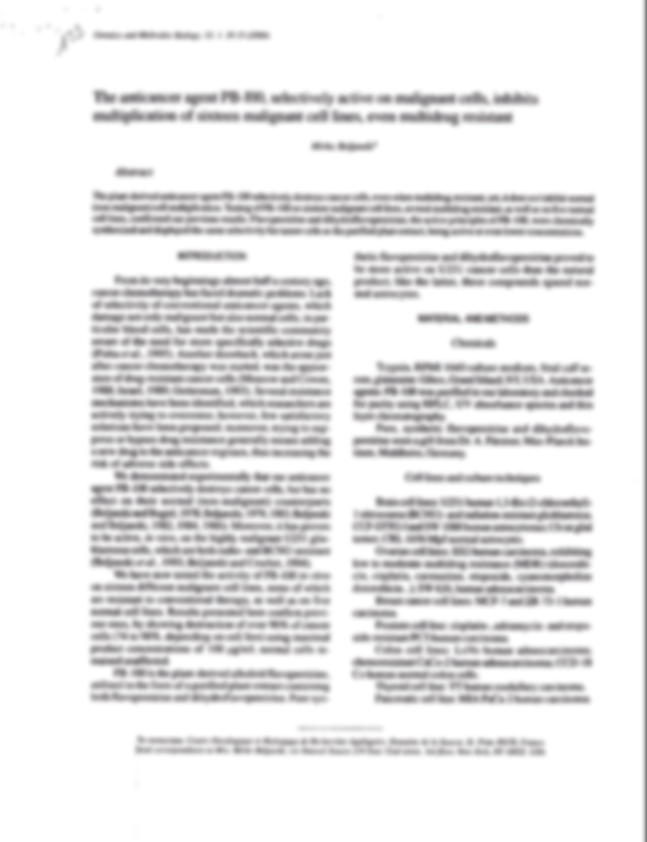50 – Nouvelle méthode de purification des “polypeptides synthétases”
VII- European J. Biochem., 1968, 4, pp. 118-125.
Available in English only
ABSTRACT: A new method for purification of “polypeptides synthetase” from Alcaligenes faecalis is described in which nucleic acids are removed by purification on DEAE-cellulose with a recovery of 60-75% of the initial enzymatic activity.
ABSTRACT: A new method for purification of “polypeptides synthetase” from Alcaligenes faecalis is described in which nucleic acids are removed by purification on DEAE-cellulose with a recovery of 60-75% of the initial enzymatic activity.
49 – Identification des sites d’attachement spécifiques d’arginine et de valine dans des ARN d’ origines différentes
VIII- European J. Biochem., 1968,4, pp. 184-189.
Article not available online
Article not available online
48 – Nouvelle méthode de purification des polypeptides-synthétases
C.R. Acad. Sci., 1967,264, pp. 411-414 (série D).
Available in French only
ABSTRACT: Une méthode nouvelle de purification des polypeptide-synthétases à partir d’extraits d’Alcaligenes faecalis permet d’obtenir à rendement élevé des préparations enzymatiques substantiellement purifiées.
ABSTRACT: Une méthode nouvelle de purification des polypeptide-synthétases à partir d’extraits d’Alcaligenes faecalis permet d’obtenir à rendement élevé des préparations enzymatiques substantiellement purifiées.
47 – Isolement de di- et trinucléotides, sites spécifiques d’attachement d’arginine et de valine dans des ARN d’ origine différente
C.R. Acad. Sci., 1967,264, pp. 1760-1763 (série D).
Available in French only
ABSTRACT: Un acide aminé donné, attaché par les polypeptide-synthétases à des ARN d’origine différente (Alcaligenes f., E. coli, TYMV) est lié à un même nucléotide spécifique dans les di- et trinucléotides isolés. Les polypeptide-synthétases peuvent directement reconnaître à la fois chaque acide aminé et les sites (triplets) dans l’ARN que nous proposons dorénavant d’appeller ARN matriciel.
ABSTRACT: Un acide aminé donné, attaché par les polypeptide-synthétases à des ARN d’origine différente (Alcaligenes f., E. coli, TYMV) est lié à un même nucléotide spécifique dans les di- et trinucléotides isolés. Les polypeptide-synthétases peuvent directement reconnaître à la fois chaque acide aminé et les sites (triplets) dans l’ARN que nous proposons dorénavant d’appeller ARN matriciel.
46 – Rôle des triterpènes dans l’attachement des l-acides aminés par des “ARN matriciels”
Eur. J. of Clin. Biol. Res., 1971, pp. 897-908
Available in French only
Summary in English
ABSTRACT: Asiaticoside, asiatic and madecassic acids affect the binding of L-14V-proline and L-14C-alanine to m-RNA in the presence of any one of the four nucleoside triphosphates and a partially purified bacterial enzyme preparation whose properties have been previously described. The binding of proline to m-RNA, but not its turnover, is inhibited by any one of the triterpenes used, while that of alanine is highly increased only by free asiatic acid. This latter inhibits the turnover of alanine bound to m-RNA thus shifting the reaction towards an accumulation of the “m-RNA-alanine” complex which is an intermediate in the synthesis of oligopeptides in the present system. The binding of L-amino acids to t-RNA in the presence of ATP is not affected by triterpenes. A hypotesis is proposed to account for the effect of triterpenes in mammalian cells in connection with biosynthesis of collagen, a protein rich in proline, hydroxyproline and alanine.
ABSTRACT: Asiaticoside, asiatic and madecassic acids affect the binding of L-14V-proline and L-14C-alanine to m-RNA in the presence of any one of the four nucleoside triphosphates and a partially purified bacterial enzyme preparation whose properties have been previously described. The binding of proline to m-RNA, but not its turnover, is inhibited by any one of the triterpenes used, while that of alanine is highly increased only by free asiatic acid. This latter inhibits the turnover of alanine bound to m-RNA thus shifting the reaction towards an accumulation of the “m-RNA-alanine” complex which is an intermediate in the synthesis of oligopeptides in the present system. The binding of L-amino acids to t-RNA in the presence of ATP is not affected by triterpenes. A hypotesis is proposed to account for the effect of triterpenes in mammalian cells in connection with biosynthesis of collagen, a protein rich in proline, hydroxyproline and alanine.
45 – L’ARN isolé du virus de la mosaïque jaune du Navet, accepteur des L-acides aminés en présence d’enzymes bactériennes
Bull. Soc. Chim. Biol. 1965, 47, pp. 1645-1652.
Available in French only
ABSTRACT: Résultats concernant la formation du complexe entre les acides L-acides aminés 14C et l’ARN purifié, isolé du virus de la mosaïque jaune du Navet.
ABSTRACT: Résultats concernant la formation du complexe entre les acides L-acides aminés 14C et l’ARN purifié, isolé du virus de la mosaïque jaune du Navet.
44 – Messenger RNA Dependent Synthesis of Peptides by Purified Bacterial Enzymes
Bioch-Zeits, 1965, 342, pp. 392-399.
Article in English, not available online
Article in English, not available online
43 – Les ARN messagers” gouvernant la synthèse ” in vitro ” des chaînes peptidiques en présence de “polypeptides synthétases
Pathologie-Biologie, 1965,13, pp. 198-203.
Available in French only
ABSTRACT: L’ARN actif a le rapport des bases proche de celui de l’ADN d’Alcaligenes faecalis et possède donc cette caractéristique de l’ARN messager. Résultats concernant recherches.
ABSTRACT: L’ARN actif a le rapport des bases proche de celui de l’ADN d’Alcaligenes faecalis et possède donc cette caractéristique de l’ARN messager. Résultats concernant recherches.
42 – Le messager ARN, accepteur spécifique des L-acides aminés en présence d’enzymes bactériennes
C.R. Acad. Sci., 1963,257, pp. 547-550.
Available in French only
ABSTRACT: Présentation des résultats qui permettent de préciser les propriétés et la nature de la fraction d’ARN capable d’accepter les L-acides aminés.
ABSTRACT: Présentation des résultats qui permettent de préciser les propriétés et la nature de la fraction d’ARN capable d’accepter les L-acides aminés.
41 – ARN-messager: intermédiaire direct dans la synthèse des liaisons peptidiques
Colloques Internationaux du C.N.R.S., Marseille, 1963, pp. 39-44.
(Mécanismes de régulation des activités cellulaires chez les micro-organismes).
Available in French only
ABSTRACT: English summary : The formation of peptides in the presence of ribonucleoside-5′-triphosphates and of polypeptide synthetases from Alcaligenes faecalis requires the participation on an RNA fraction. Active RNA obtained from these bacteria has been identified by several procedures as being messenger RNA and has been partially purified by ammonium-sulfate fractionation. This RNA fraction has the ability to fix un-competitively L-amino-acids, forming a “RNA-AA” complex which, when isolated and incubated again in Tris buffer without the addition from various origins, acts as an amino-acids acceptor in the presence of Alcaligenes faecalis enzymes.
ABSTRACT: English summary : The formation of peptides in the presence of ribonucleoside-5′-triphosphates and of polypeptide synthetases from Alcaligenes faecalis requires the participation on an RNA fraction. Active RNA obtained from these bacteria has been identified by several procedures as being messenger RNA and has been partially purified by ammonium-sulfate fractionation. This RNA fraction has the ability to fix un-competitively L-amino-acids, forming a “RNA-AA” complex which, when isolated and incubated again in Tris buffer without the addition from various origins, acts as an amino-acids acceptor in the presence of Alcaligenes faecalis enzymes.




